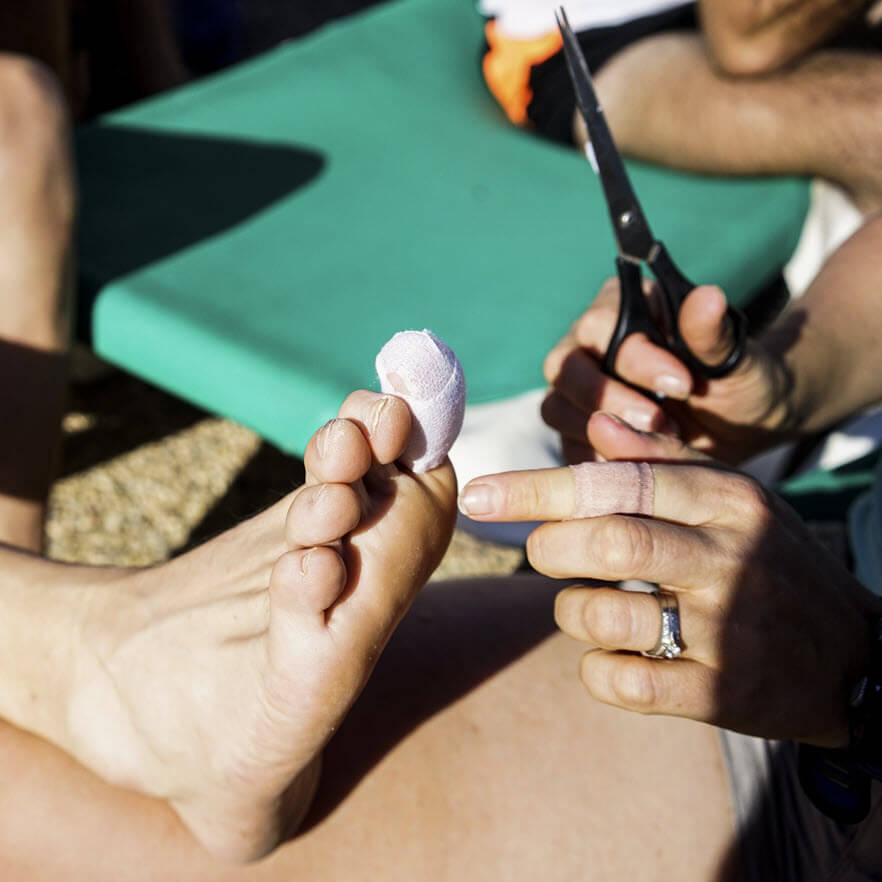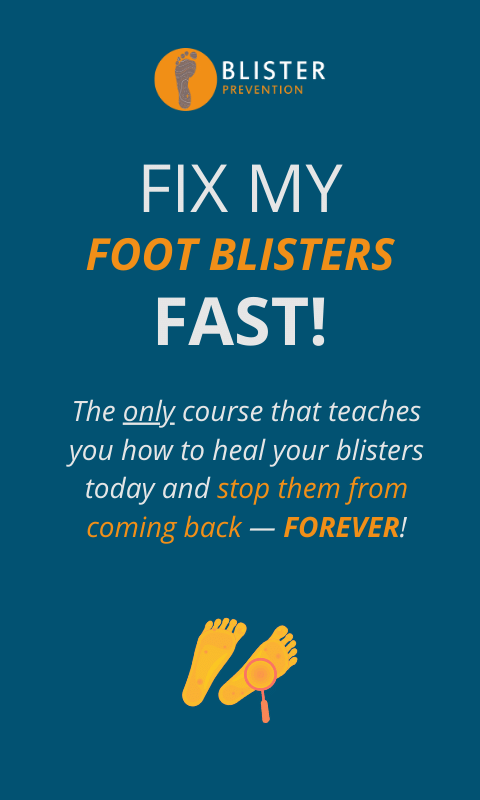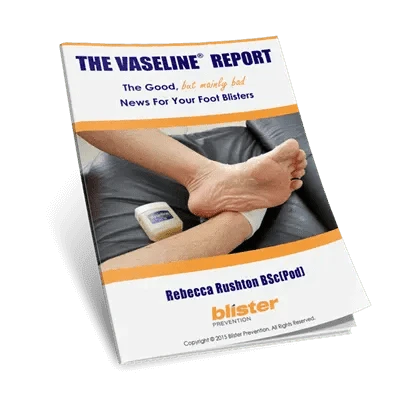Blister prevention taping is the most popular blister prevention strategy going around. Sports medicine professionals, athletes, active people of all persuasion and your everyday blister prone individual, we've all relied upon it at some point to protect our feet. If you're eager to try it, check out these 3 blister taping techniques below and have a go yourself. The blister tape we used here is Fixomull Stretch (also known as CoverRoll Stretch in the USA).
Blister Prevention Taping Techniques
1) Toes
2) Ball of Your Foot
3) Heels
Alternative Sources of Taping Information
- Fellrnr is definitely worth a read: https://fellrnr.com/wiki/Taping
- John Vonhof of Fixing Your Feet: https://www.fixingyourfeet.com/taping-for-blisters/
- This ball-of-foot taping technique video for the ball of the foot is even better than the embedded video above - it shows the pros and cons of 3 different techniques.
Tapes Used For Blister Prevention
- Fixomull Stretch (also known as CoverRoll Stretch)
- Leukoplast's range - includes Leukotape P and Leukotape K, Leukotape Classic, Strappal and Tensoplast
- Elastoplast Rigid Strapping Tape
- Elastikon
- RockTape
- KinesioTex
- Duct tape and gaffa tape
- Moleskin (you can get stretchy and rigid versions)
- Paper tape (also known as Micropore)
A word on duct tape: The adhesive of duct tape and gaffa tape is not of medical grade. They are for industrial use, not intended to be used on the skin. Skin irritation is a potential side-effect.
Which Blister Tape Works Best?
Obvious question. The truth is, there is no consensus on which tape works best. Weird, right?
Actually it's no surprise. That's because we don't know how blister taping works (more on that shortly). So, considering we don't know how tape works, its widespread use is surprising. Go to any sports medicine professional with blister issues and you'll be getting your feet taped. And they'll show you how to do it yourself. I'm no different. It's hard-wired in us! It makes logical sense. But does that logic stand up? Let's look at the research first.
Research On The Effectiveness Of Blister Prevention Taping
This will be quick, I assure you!
There is a distinct lack of research on taping for blister prevention. This is from American Podiatrist and blister researcher Doug Richie in his 2010 literature review:
Other topical agents that have been advocated for blister prevention include moleskin, tape ... and viscoelastic dressings. However, there are no published studies to show these measures actually work.
Doug Richie DPM, 2010
The paper tape studies (Pre-Taped I & II)
Since Richie's literature review in 2010, two prospective randomised trials using preventive blister taping have been published (2014 and 2016). Competitors of Racing the Planet 250km, 7-day self-supported ultramarathons were the subjects. The lead researcher of both papers was Dr Grant Lipman. The same intervention, 3M Micropore paper tape (also known as surgical tape) was used in each study. The methodology of each study differed.
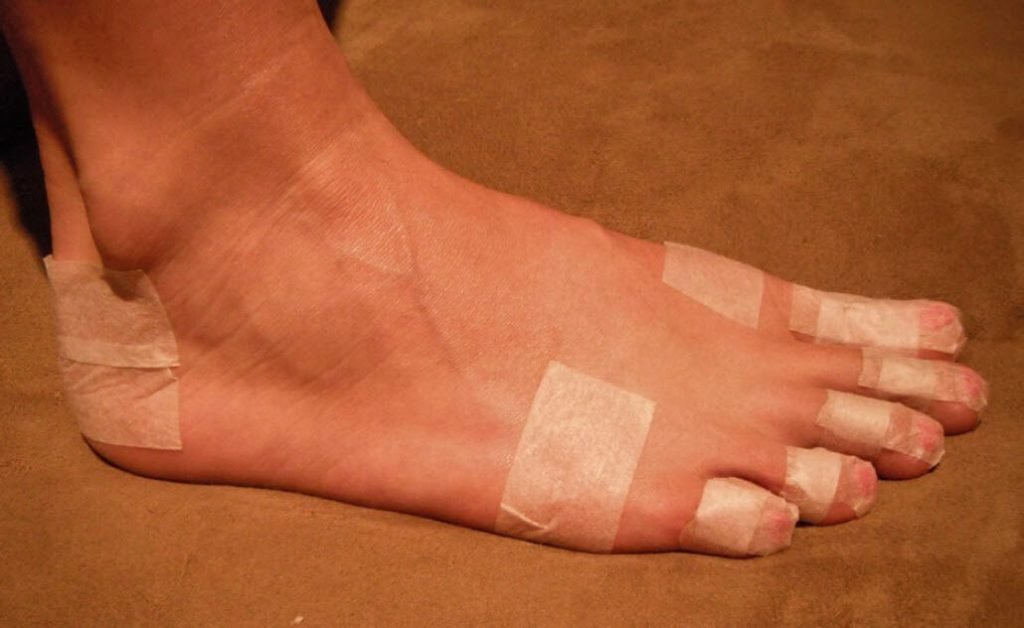
The blister pre-taping procedure in the first study
Both studies used the same outcome measure: if the first blister developed on an untaped area, the intervention was deemed successful; if the first blister developed underneath a taped area, the intervention was deemed unsuccessful.
- The first study found the paper tape did not prevent blisters
- The second study found it did
The main difference between each study was:
- The first study compared one taped foot to the other untaped foot
- The second study compared taped areas of one foot to untaped areas of the same foot
The limitations of both studies included:
- No blinding
- Unable to rule out the intervention being used inappropriately
- Inability to rule prevent additional strategies being used in conjunction with the intervention tape
- And data collection by questionnaire
Of note, the ‘end point’ of data collection for both studies was the development of the first blister. This was on day one for 66% (2014) and 50% (2016) of subjects; and on day two for 23% (2014) and 30% (2016). So by day two, data collection for this research ceased for 89% (2014) and 80% (2016) of the subjects.
One discussion item that was mentioned in both papers was that of the tape's low adhesion. It was seen as:
A benefit in one way - in that if a blister formed underneath the tape, then removing the tape was unlikely to tear the blister roof.
A limitation in another way - in that it was not uncommon that the tape came off prematurely, particularly in wet conditions.
What Does This All Mean?
It means we can't tell you for sure whether blister prevention taping will work for you, what blister tape works best, or how best to apply it. I mean, at this stage, the jury is still out even on the effectiveness of blister taping, in spite of the research above. But at least someone is doing research on a blister prevention strategy!
You know, the results above mirror the real life experience with blister prevention taping - results are mixed. From a personal standpoint, I've had mixed results too. While I'm sure it helped, it wasn't unusual for me to get blisters in spite of taping. As in, I can get a blister form underneath my excellently-performed and intact taping job. That's what made me look further into blister management all those years ago. If I couldn't stop my own blisters, as a podiatrist, how could I expect to help my patients with blister problems!
How Does Blister Pre-taping Actually Work?
It's hard to believe we haven't figured this out yet. To be honest, I just think nobody has bothered to think too hard about it yet. There are more exciting things to focus on in sports medicine and podiatry, like musculoskeletal injuries and foot surgery.
I've thought a lot about this subject, because of my own blister prone feet. As I published in Lower Extremity Review I can think of four ways taping can help in preventing blisters:
1. Protection From The Abrasive Effects Of Rubbing
Tape does this well. It's stuck to your skin. As such, nothing abrasive can rub or scratch against your skin (sand, grit, the roughness of your sock, scratchy shoe seams etc). That's absolutely helpful. But this describes abrasion prevention, not blister prevention - it's not rubbing that causes blisters. Abrasions and blisters are different injuries. We've known for decades that blisters are causes by repetitive shear distortions.
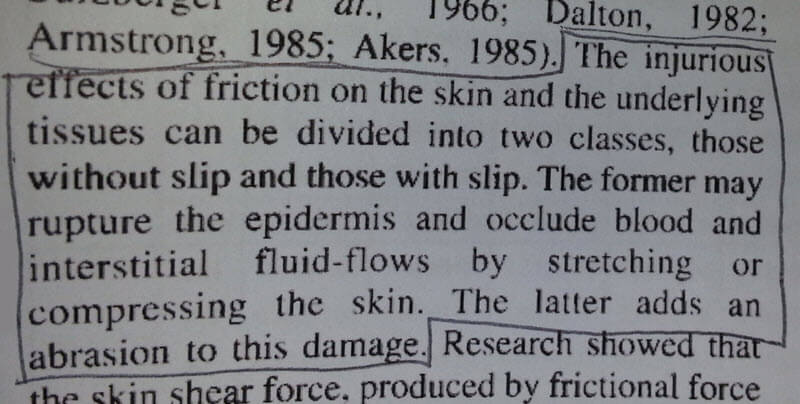
Zhang and Mak (1999) recognise blisters are caused by shear and are deroofed by rubbing
2. Thermal Insulation
A blister discussion on Podiatry Arena in 2013 explored another possibility around thermal insulation from the heat produced by rubbing. However, we know blisters don’t require rubbing across the skin to form. And we know blisters are not thermal burns. But it is plausible that heat is indirectly causative, as Comaish (1973) and Kirby (2013) point out.
Although plausible, research to date does not support the theory that local surface heat generated by dynamic friction is a significant factor in blister formation. If heat transfer from the skin surface to the stratum spinosum is a major factor in blister development, one would expect higher friction levels and faster rubbing would increase blister occurrence. Naylor (1955) found this not to be the case (below). And one would expect the thicker corneum of the soles and palms would afford a level of blister protection. In fact, a thick corneum is one of the requisites for blister formation (Naylor, 1955; Akers and Sulzberger, 1972). You can check out their research here.

Naylor's results from 1955 show that higher temperatures don't increase blister incidence. So thermal insulation is unlikely to provide blister prevention.
3. Reducing Friction Levels
I’ve assumed tapes reduce blister causing forces by lowering the friction level. But we don't know whether they do or don't. Because none of the tapes used in blister prevention (Fixomul, Micropore, Leukoplast, Kinesio, RockTape, paper tape...) have had their friction properties tested in any research, except moleskin. Not even by their manufacturers - I've asked them! There is no coefficient of friction (COF) data for any sports tapes! Some in-shoe material COF data does exist.
Also, Polliack and Scheinberg (2006) measured the COF of some blister dressing, but not tapes, except moleskin. This fact is quite alarming and represents a huge area for improving our understanding of how blister taping works. And provide some guidance on which tapes would work better than others. To be fair though, none of the tapes I've mentioned at the start of this article are made specifically for blister prevention, except moleskin. Musculoskeletal injuries are their primary use.
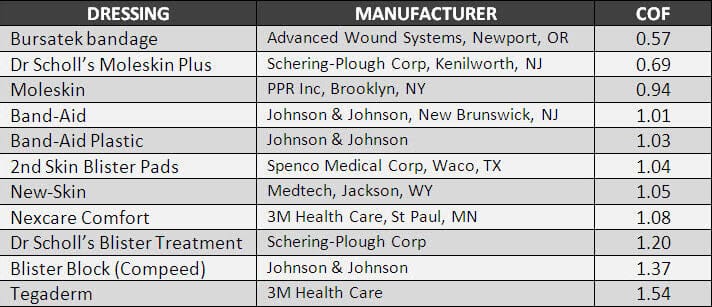
Polliack and Scheinberg (2006) measured the COF of several blister dressings
4. Spreading Shear Load
Another possibility first mentioned in 2013 in The Advanced Guide to Blister Prevention is a spreading of shear load. Marty Carlson (CPO) of Tamarack Habilitation Technologies Inc. mentioned this as a potential mechanism of action in a conversation we were having about blister prevention. It has since been mentioned here and here.
An alternative mechanism of action – Although not described in the literature, it is plausible that tapes reduce shear at discrete locations due to the fact that they’re adhered to the skin. Just as cushioning spreads the vertical load over a larger area to reduce peak pressure, because tape is adhered to the skin, does tape spread the ‘pull’ of the horizontal load over a larger area to reduce peak shear distortion per unit area of skin? In other words, by spreading the shear load, shear per unit area of skin will be less (Carlson, 2013: personal communication). The Advanced Guide To Blister Prevention , 2013
If this was the case, you would think a rigid (non-stretchy) tape would work best. Interestingly, most blister tapes are stretchy! Stretchy tapes are easier to apply smoothly to the skin, particularly the curvy bendy areas like your toes. But perhaps we should be using a rigid sports tape instead, and trying harder not to leave creased and folded-over pieces. At least on large flat areas of your foot it's easy to use a rigid tape. Rigid tapes helped my back-of-heel blisters, back in the day. But it wouldn't stop me from getting blisters if I went for a long enough walk (and I'm not talking very long at all).
How To Get The Most Out Of Blister Taping?
So you'd like to try preventive blister taping on your feet? Great - you absolutely should try it. Here are a few things you need to know:
It takes time:
As blister taping expert John Vonhof, author of ‘Fixing Your Feet’ says in his high quality taping blog post “It takes as long as it takes to do it right.” This could be a problem in a race situation. But also consider if you need to tape on a day to day basis. That 5-10-30 minutes before you head out becomes a bit of a bane (it did for me anyway).
It takes skill:
It might look easy, but it takes practice to ensure a good job. If you want to see how other people tape their feet, in the following video links, Anna Beetham takes Oxfam Trailwalkers through some taping techniques for the toes, big toe joint and heels.
When tape becomes a blister cause:
The result of poor application technique and/or inadequate adhesion is a doubled over bit of tape that becomes a blister-causing irritant. Beware!
Getting it to stay stuck:
Some tapes stick better than others. Sweating is a constant compromise to adhesion, particularly when you're exercising. One way to maximise tape adhesion is with an adhesive enhancer, like Compound Tincture of Benzoin (TBCo) or Skin-Prep. You wipe these on the skin, allow it to dry and then apply your tape. It can be a bit messy but it's one way to maximise adhesion. Another threat to adhesion is environmental moisture – body run-off (sweat, rain, drink stations), dew-laiden grass, river crossings etc. John Vonhof has trialed many kinesiology tapes in extreme athletic and environmental conditions and has a few recommendations in his taping in the Amazon blog post - particularly a tape called StrengthTape.
Taping Tips From John Vonhof
- Round the corners.
- Rub or hold the tape down for 30 seconds after applying it to the skin. This warms the adhesive to make it more tacky so it sticks better.
- Apply tape at least one hour before use (or even the night before). It gives the tape's adhesive more time to bond with the skin.
- When using kinesiology tapes, lay the tape on the skin. The more stretch you apply, the more likely the tape is to come loose, especially in wet conditions.
- It takes as long as it takes - a precision blister pre-taping job can take 30 minutes.
- Practice makes perfect!
What's next?
Clearly, we have a little more work to do in understanding preventive blister taping - how it works, how it doesn't work, which tape for which conditions, which tape for which foot region and specifics about application technique. For a modality that is arguably the most common blister prevention strategy, it's odd that we know so little about it.
References
- Akers WA and Sulzberger MB. 1972. The Friction Blister. Military Medicine. 137: 1-7.
- Comaish JS. 1973. Epidermal Fatigue as a Cause of Friction Blisters. The Lancet. Jan 13: 81-83.
- Naylor P. 1955. Experimental friction blisters. British Journal of Dermatology. 67: 327–42.
- Polliack AA and Scheinberg S. 2006. A New Technology of Reducing Shear and Friction Forces on the Skin: Implications for Blister Care in the Wilderness Setting. Wilderness and Environmental Medicine. 17: 109-119.
- Richie D. 2010. How to manage friction blisters. Podiatry Today. 23 (6): 42-48.
- Vonhof J. 2011. Fixing Your Feet – Injury Prevention and Treatment for Athletes (5th edition). Wilderness Press.
- Zhang M and Mak AFT. 1999. In vivo friction properties of human skin. Prosthetics and Orthotics International. 23: 135-141.
- Lipman GS, Ellis MA, Lewis EJ, Waite BL, Lissoway J, Chan GK, Krabak BJ. 2014. A prospective randomized blister prevention trial assessing paper tape in endurance distances (Pre-TAPED). Wilderness & Environmental Medicine. Published Online: October 30, 2014.
- Lipman GS, Sharp LJ, Christensen M, Phillips C, DiTullio A, Dalton A, Ng P, Shangkuan J, Shea K and Krabak BJ. 2016. Paper tape prevents foot blisters: A randomised prevention trial assessing paper tape in endurance distanced II (Pre-TAPED II). Clinical Journal of Sports Medicine. Published Online: April 14, 2016.
- Taping for blister prevention using duct tape
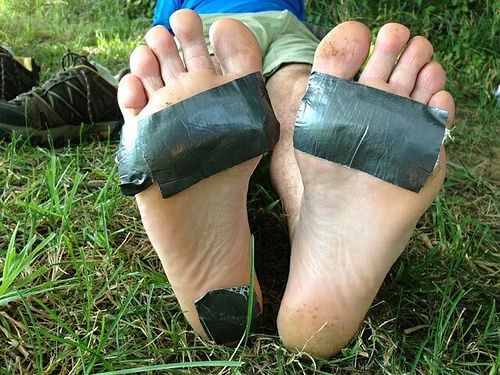 Taping for blister prevention using duct tape (Image credit). Note: The adhesive of duct tape and gaffa tape is not of medical grade and not intended to be used on the skin. These tapes are made for industrial use.
Taping for blister prevention using duct tape (Image credit). Note: The adhesive of duct tape and gaffa tape is not of medical grade and not intended to be used on the skin. These tapes are made for industrial use.
